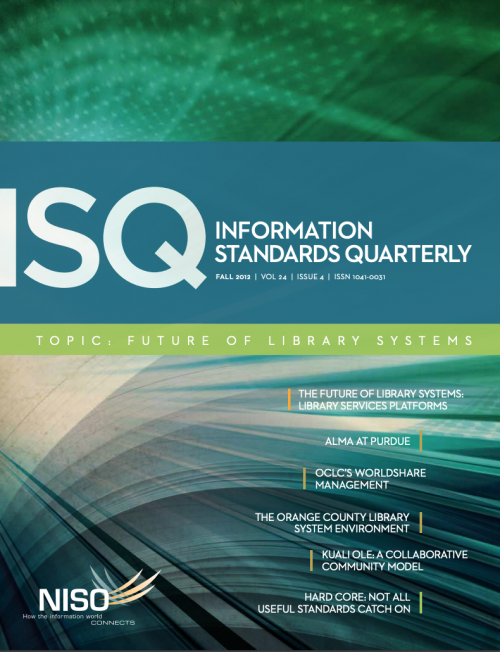Information Standards Quarterly, Fall 2012
Letter from the Editor
This issue of Information Standards Quarterly on the future of library Systems spotlights the topic of the new generation of products that I call library Services Platforms. the earlier term integrated library systems (ils) is associated with the functionality and concepts associated with managing print collections and the metadata about them. these new products and projects cast a wider net, consistent with the expansion of library collections to include a complex assemblage of electronic and digital materials in addition to their physical inventories.
Electronic materials, such as subscription-based, open access, and repository-based articles, e-books, multi-media content, and the like come with an entirely different—and usually more complex—set of business rules and policies that impact how libraries acquire, describe, and manage these materials and also govern how access by their patrons can be mediated. Digital collections, such as the images, manuscripts, sound recordings, and video materials that a library might create and curate come with yet another set of issues and requirements, such as support of digitization workflows, intellectual property rights, preservation, and asset management.
Each of the new library services platforms takes a different tack on what categories of materials fall within its scope, the technical architectures, and how each interacts with other components of the library’s technical infrastructure or other business and information systems that comprise the broader ecosystem in which libraries operate. These new systems present different interoperability scenarios than may have applied to the previous generation of ILS or even electronic resource management (ERM) systems. For example, some entirely abandon the concept of the traditional online catalog in favor of complete reliance on discovery services. This arrangement brings a need to accomplish all patron interactions through APIs rather than through proprietary internal programming. These new products also tend to emphasize capabilities to interact with other business systems, such as those for enterprise resource planning (ERP), student records management, learning management systems, or courseware platforms—as well as authentication or single sign-on services. In general terms, I see these new systems as rearranging much of the automation infrastructure in ways that impact many of the standards, protocols, and best practices available. While many of these mechanisms may remain relevant, the need for some may be obviated and the need for attention to standardized interoperability in other areas may be exposed.
This issue of ISQ presents a wide range of products and projects from this new realm of library services platforms. Carl Grant delivers an excellent overview of this new genre, describes some of their general characteristics, and provides a brief introduction to each of the major products. But how are these products doing in the real world? To help answer that question, we include a set of articles from libraries with direct experience of several of them. Paul Bracke relates the experience of the Purdue University Libraries as a development partner with Ex Libris for Alma and how it fits within that institution’s strategic transformation already underway. Gentry Holbert presents the experience of Spring Hill College as one of the early adopters of WorldShare Management Services from OCLC. William Erick Atkinson describes how the Orange County Library System migrated from the Innovative Interfaces' Millennium ILS to that company’s Sierra services platform, taking advantage
of its APIs to enable integration with a variety of local applications. Michael Winkler and Robert H. McDonald provide an overview and update of the Kuali OLE project that is building a next-generation, enterprise-oriented library system to be made available as open source software.
Ted Koppel of Auto-Graphics contributes an article on the Cost of Resource Exchange, or CORE, standard that was designed to help to improve the communication of financial information between applications such as integrated library systems and electronic resource management systems. This is a case where the standard never saw significant adoption (and was thus released instead as a recommended practice), at least partially due to the shift away from dedicated electronic resource management systems to subsuming this area of functionality within more comprehensive library services platforms.
As the guest editor of this issue of Information Standards Quarterly, it was great to read about how these products— that I have been following through their respective stages of conceptual design, engagement with development partners, and eventually into production use in libraries—are doing in the real world. Thanks to all of the authors who have contributed to this issue, which I hope ISQ readers will find informative regarding this new phase of library systems.
Marshall Breeding | Independent consultant, speaker, and author; creator and editor of Library Technology Guides and the lib-web-cats online directory of libraries on the Web.
